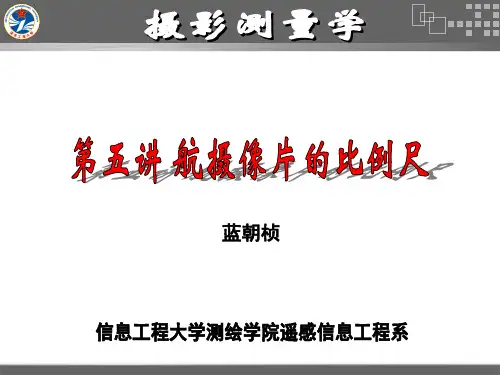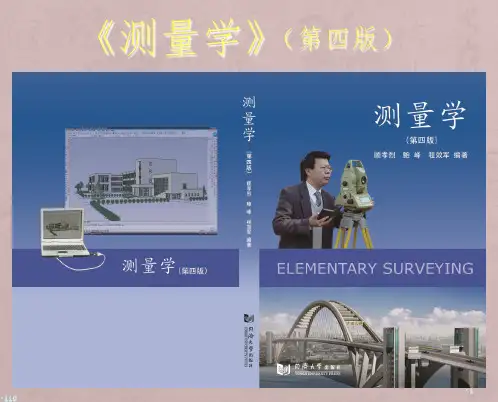- 1、下载文档前请自行甄别文档内容的完整性,平台不提供额外的编辑、内容补充、找答案等附加服务。
- 2、"仅部分预览"的文档,不可在线预览部分如存在完整性等问题,可反馈申请退款(可完整预览的文档不适用该条件!)。
- 3、如文档侵犯您的权益,请联系客服反馈,我们会尽快为您处理(人工客服工作时间:9:00-18:30)。
We often need to resample a digital image into a different geometry, for example, to create an orthophoto. Any type of geometric transformation, including similarity, affine, projective, polynomial, etc. , can be applied to a digital image in exactly the same way as to any two-dimensional set of coordinates.
1 x 2 fl
fl is cutoff
frequency(Nyquist rate)
当采样间隔能使在函数g(x)中存 在的最高频率中每周期取有两个 样本时,则根据采样数据可以完 全恢复原函数g(x)
Digital Image Expression
g0,0 g 0,1 g0,n1 g g1,1 g1,n1 1, 0 g g m1,0 g m1,1 g m1,n1
g0,0 g1,0 g0,1 g1,1 … … … … g0,n-1 g1,n-1
gm-1,0 gm-1,1 …
…
…
…
…
…
gm-1,n-1
4
…
数字影像或数字化影像
To Obtain Digital Image
Each pixel of a digital image is a direct or indirect sample of the continuous incident light distribution.
Figure. Instantaneous field of view (IFOV) and ground sample distance (GSD)
– A larger IFOV means that one pixel covers a larger portion of the scene or, equivalently, that the image will have lower spatial resolution.
8
Pixel, IFOV and GSD
Another measure related to pixel size is the ground sample distance (GSD), which is the projection of the pixel size onto the ground plane (Fig. ).
9
Pixel, IFOV and GSD
This is often used erroneously as a synonym for resolution. – In fact, the resolution of a digital image is determined by both the sensor geometry and by factors external to the sensor, such as atmospheric conditions, platform motion, etc. The actual resolution may be as good as indicated by the GSD, but in practical applications it is often lower.
Instantaneous field of view (IFOV) 瞬时视场 ground sample distance (GSD) 地面采样间隔(距离)
Figure . Instantaneous field of view (IFOV) and ground sample distance (GSD)
DIGITAL IMAGERY
A digital image is a regular array of pixels, or picture elements, and is described in terms of its geometry and its radiometry.
数字影像是一个灰度矩阵g,矩阵中每个元素gi,j,是一个灰度值,对 应着光学影像或实体的一个微小区域,称为像元素或像元或像 素(Pixel=Picture element )。各像元素的灰度值gi,j,代表其 影像经采样与量化了的“灰度级”
–
14
What happens if we don't sample at a high enough rate?
–
The higher-frequency components of the signal, which correspond to the fine details in the image, are incorrectly interpreted as lower-frequency components. These erroneous components confuse the overall signal reconstruction, a phenomenon known as aliasing(混淆 ).
SOLUTION
The IFOV is
0.015 / 2 IFOV 2 tan 1 0.000015rad 1000
and the GSD is GSD = IFOV(650,000) = 9.75 m
11
1. Digital Image Sampling
Digital images sample a continuous analog input image at discrete points and assign a discrete intensity value at each point. How can we determine whether all the information in the original image is present in its sampled digital form or, equivalently, what spatial sampling rate is required to fully capture the input?
15
For digital images, the lens and the pixel both act as apertures, limiting the maximum detail visible in the image. For most aerial cameras, the lens (and film, if a scanner is used) usually have much higher resolution than the commonly used pixel sizes can record, so the pixel size determines the effective aperture.
6
Pixel, IFOV and GSD
Pixels may be arranged in any regular pattern, but in practice most sampling grids are square or rectangular (一般为矩形格网) . Hexagonal grids(六角形格网) have some theoretical advantages but have seldom been implemented. The ratio between pixel width and pixel height is known as the aspect ratio(纵横比); a square pixel has an aspect ratio of one.
13
The answer to this question relies on sampling theory.
Sampling theory states that a band-limited signal with a highest frequency of ω can be exactly reconstructed with a sampling rate of 2ω. (当采样频率大于信号中最高频率的2倍时,采样之后的数 字信号完整地保留了原始信号中的信息) – In terms of wavelength, a signal with a minimum wavelength of λ must be sampled with a sample spacing of no greater than λ/2. The theoretical minimum sampling rate required is known as the Nyquist rate.
7
Digital images are often described in terms of their pixel size, but can also be specified in terms of the instantaneous field of view (IFOV)瞬 时视场, which is the angle determined by the pixel size and the focal length. As shown in Fig. , as the focal length decreases or the pixel size increases, the IFOV increases.
x x0 i x y y 0 j y (i 0,1, n 1) ( j 0,1, m 1)









